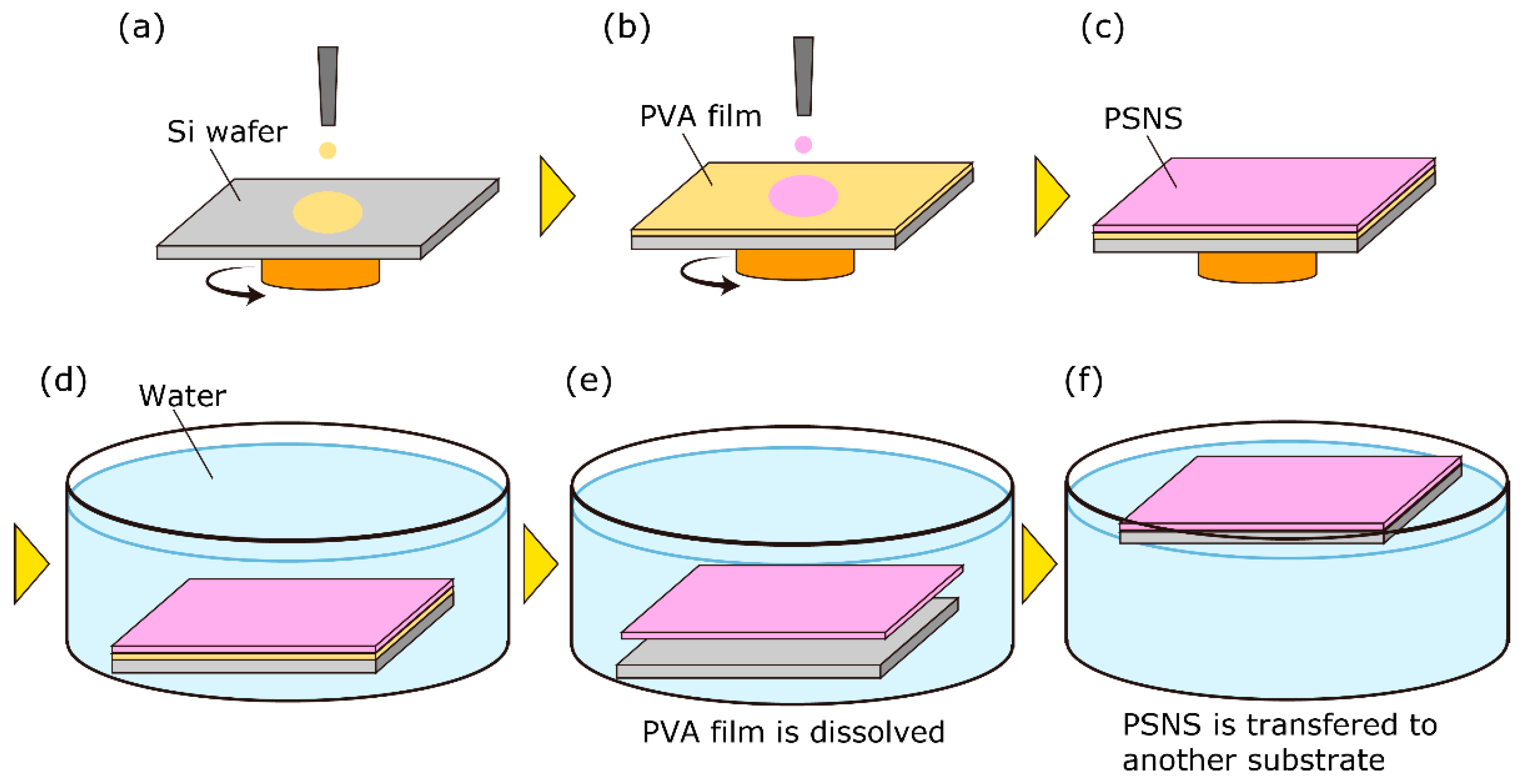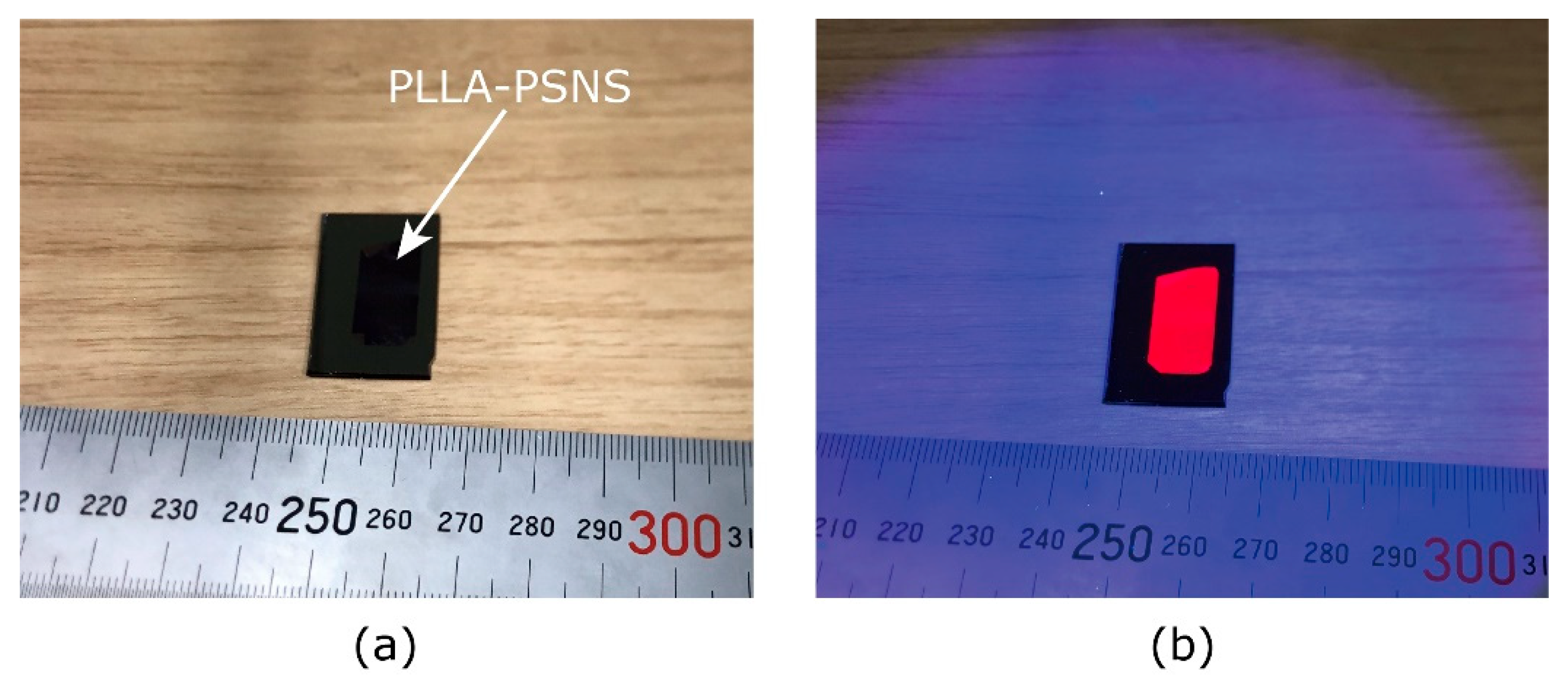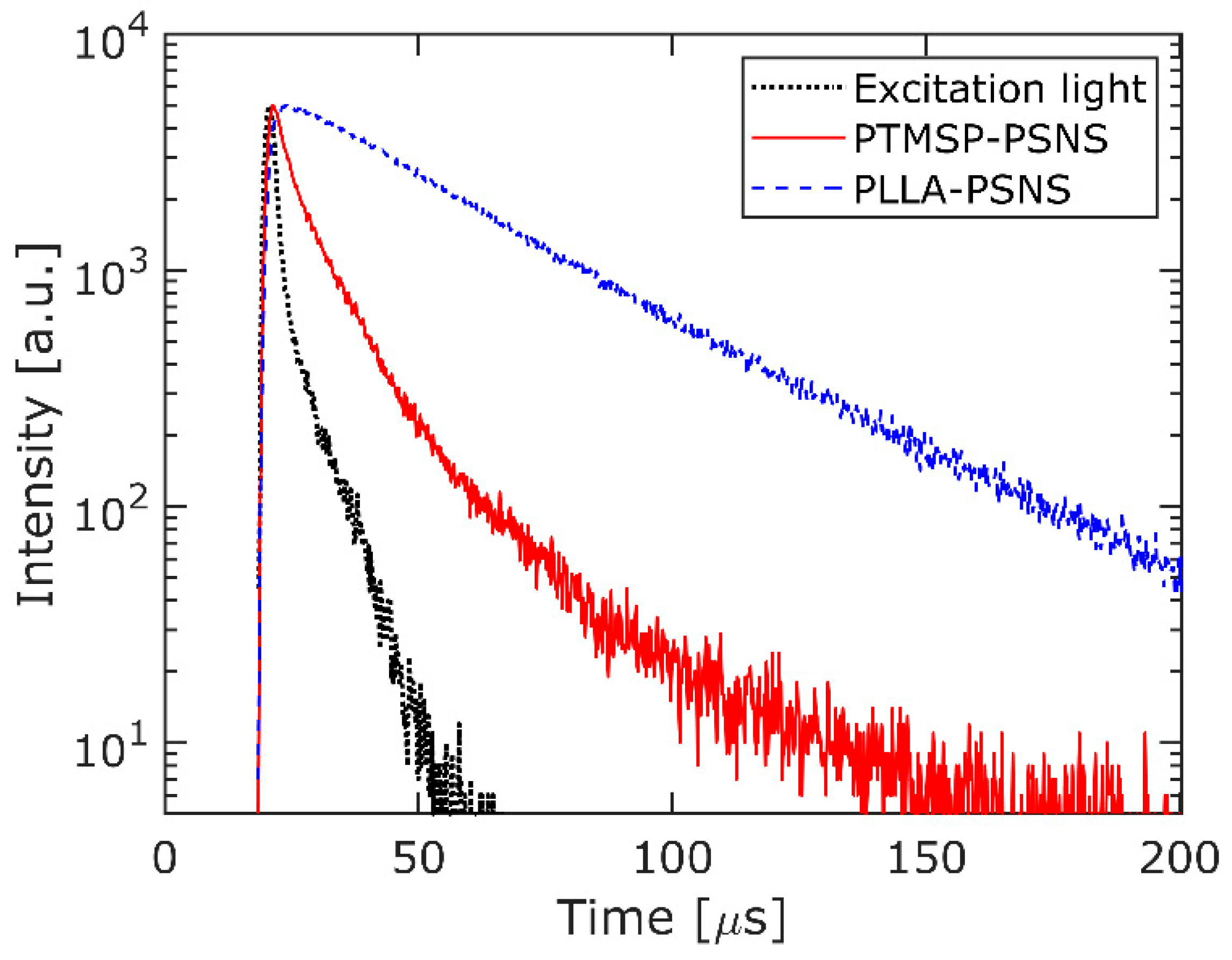Pressure-Sensitive Nano-Sheet for Optical Pressure Measurement
Abstract
:1. Introduction
2. Basic Principles of PSNS
3. Materials and Methods
3.1. Fabrication of PSNS
3.2. Experimental Setup
4. Results and Discussion
5. Conclusions
Author Contributions
Funding
Institutional Review Board Statement
Informed Consent Statement
Data Availability Statement
Acknowledgments
Conflicts of Interest
References
- Liu, T.; Sullivan, J.P. Pressure and Temperature Sensitive Paints; Springer: Berlin, Germany, 2005. [Google Scholar]
- Bell, J.H.; Schairer, E.T.; Hand, L.A.; Mehta, R.D. Surface Pressure Measurements using Luminescent coatings. Annu. Rev. Fluid Mech. 2001, 33, 155–206. [Google Scholar] [CrossRef]
- Gregory, J.W.; Asai, K.; Kameda, M.; Liu, T.; Sullivan, J.P. A review of pressure-sensitive paint for high-speed and unsteady aerodynamics. Proc. Inst. Mech. Eng. Part G J. Aerosp. Eng. 2008, 222, 249–290. [Google Scholar] [CrossRef]
- Liu, T.; Sullivan, J.P.; Asai, K.; Klein, C.; Egami, Y. Pressure and Temperature Sensitive Paints, 2nd ed.; Springer: Cham, Switzerland, 2021. [Google Scholar] [CrossRef]
- Disotell, K.J.; Nikoueeyan, P.; Naughton, J.W.; Gregory, J.W. Global surface pressure measurements of static and dynamic stall on a wind turbine airfoil at low Reynolds number. Exp. Fluids 2016, 57, 82. [Google Scholar] [CrossRef]
- Sugioka, Y.; Koike, S.; Nakakita, K.; Numata, D.; Nonomura, T.; Asai, K. Experimental analysis of transonic buffet on a 3D swept wing using fast-response pressure-sensitive paint. Exp. Fluids 2018, 59, 108. [Google Scholar] [CrossRef]
- Running, C.L.; Sakaue, H.; Juliano, T.J. Hypersonic boundary-layer separation detection with pressure-sensitive paint for a cone at high angle of attack. Exp. Fluids 2019, 60, 23. [Google Scholar] [CrossRef]
- Jiao, L.; Chen, Y.; Wen, X.; Peng, D.; Liu, Y.; Gregory, J.W. Resolving vortex-induced pressure fluctuations on a cylinder in rotor wake using fast-responding pressure-sensitive paint. Phys. Fluids 2019, 31, 055106. [Google Scholar] [CrossRef]
- Peng, D.; Xie, F.; Liu, X.; Lin, J.; Li, Y.; Zhong, J.; Zhang, Q.; Liu, Y. Experimental study on hypersonic shock–body interaction between bodies in close proximity using translucent fast pressure- and temperature-sensitive paints. Exp. Fluids 2020, 61, 120. [Google Scholar] [CrossRef]
- Inoue, T.; Matsuda, Y.; Ikami, T.; Nonomura, T.; Egami, Y.; Nagai, H. Data-Driven Approach for Noise Reduction in Pressure-Sensitive Paint Data Based on Modal Expansion and Time-Series Data at Optimally Placed Points. arXiv 2021, arXiv:2103.00931. [Google Scholar]
- Egami, Y.; Hasegawa, A.; Matsuda, Y.; Ikami, T.; Nagai, H. Ruthenium-based fast-responding pressure-sensitive paint for measuring small pressure fluctuation in low-speed flow field. Meas. Sci. Technol. 2021, 32, 024003. [Google Scholar] [CrossRef]
- Kameya, T.; Matsuda, Y.; Yamaguchi, H.; Egami, Y.; Niimi, T. Pressure-sensitive paint measurement on co-rotating disks in a hard disk drive. Opt. Lasers Eng. 2012, 50, 82–86. [Google Scholar] [CrossRef]
- Disotell, K.J.; Peng, D.; Juliano, T.J.; Gregory, J.W.; Crafton, J.W.; Komerath, N.M. Single-shot temperature- and pressure-sensitive paint measurements on an unsteady helicopter blade. Exp. Fluids 2014, 55, 1671. [Google Scholar] [CrossRef] [Green Version]
- Peng, D.; Jiao, L.; Yu, Y.; Liu, Y.; Oshio, T.; Kawakubo, T.; Yakushiji, A. Single-shot lifetime-based PSP and TSP measurements on turbocharger compressor blades. Exp. Fluids 2017, 58, 127. [Google Scholar] [CrossRef]
- Wong, O.D.; Watkins, A.N.; Goodman, K.Z.; Crafton, J.; Forlines, A.; Goss, L.; Gregory, J.W.; Juliano, T.J. Blade Tip Pressure Measurements Using Pressure-Sensitive Paint. J. Am. Helicopter Soc. 2018, 63, 1–11. [Google Scholar] [CrossRef] [Green Version]
- Niimi, T.; Yoshida, M.; Kondo, M.; Oshima, Y.; Mori, H.; Egami, Y.; Asai, K.; Nishide, H. Application of Pressure-Sensitive Paints to Low-Pressure Range. J. Thermophys. Heat Transf. 2005, 19, 9–16. [Google Scholar] [CrossRef]
- Mori, H.; Niimi, T.; Hirako, M.; Uenishi, H. Pressure sensitive paint suitable to high Knudsen number regime. Meas. Sci. Technol. 2006, 17, 1242–1246. [Google Scholar] [CrossRef]
- Kasai, M.; Sasaki, D.; Nagata, T.; Nonomura, T.; Asai, K. Frequency Response of Pressure-Sensitive Paints under Low-Pressure Conditions. Sensors 2021, 21, 3187. [Google Scholar] [CrossRef]
- Matsuda, Y.; Nagashima, F.; Yamaguchi, H.; Egami, Y.; Niimi, T. Unsteady 2D measurement of dissolved oxygen distribution using luminescent sensor film. Sens. Actuators B Chem. 2011, 160, 1464–1467. [Google Scholar] [CrossRef]
- Huang, C.-Y.; Hu, Y.-H.; Wan, S.-A.; Nagai, H. Application of pressure-sensitive paint for the characterization of mixing with various gases in T-type micromixers. Int. J. Heat Mass Transf. 2020, 156, 119710. [Google Scholar] [CrossRef]
- Huang, C.; Gregory, J.W.; Sullivan, J.P. Microchannel Pressure Measurements Using Molecular Sensors. J. Microelectromech. Syst. 2007, 16, 777–785. [Google Scholar] [CrossRef]
- Nagai, H.; Naraoka, R.; Sawada, K.; Asai, K. Pressure-Sensitive Paint Measurement of Pressure Distribution in a Supersonic Micronozzle. AIAA J. 2008, 46, 215–222. [Google Scholar] [CrossRef]
- Matsuda, Y.; Uchida, T.; Suzuki, S.; Misaki, R.; Yamaguchi, H.; Niimi, T. Pressure-sensitive molecular film for investigation of micro gas flows. Microfluid. Nanofluid. 2011, 10, 165–171. [Google Scholar] [CrossRef]
- Matsuda, Y.; Misaki, R.; Yamaguchi, H.; Niimi, T. Pressure-sensitive channel chip for visualization measurement of micro gas flows. Microfluid. Nanofluid. 2011, 11, 507–510. [Google Scholar] [CrossRef]
- Li, X.; Zhang, G.; Bai, X.; Sun, X.; Wang, X.; Wang, E.; Dai, H. Highly conducting graphene sheets and Langmuir-Blodgett films. Nat. Nanotechnol. 2008, 3, 538–542. [Google Scholar] [CrossRef] [Green Version]
- Okamura, Y.; Kabata, K.; Kinoshita, M.; Saitoh, D.; Takeoka, S. Free-Standing Biodegradable Poly(lactic acid) Nanosheet for Sealing Operations in Surgery. Adv. Mater. 2009, 21, 4388–4392. [Google Scholar] [CrossRef]
- Coleman, J.N.; Lotya, M.; O’Neill, A.; Bergin, S.D.; King, P.J.; Khan, U.; Young, K.; Gaucher, A.; De, S.; Smith, R.J.; et al. Two-Dimensional Nanosheets Produced by Liquid Exfoliation of Layered Materials. Science 2011, 331, 568–571. [Google Scholar] [CrossRef] [Green Version]
- Okamoto, M.; Kurotobi, M.; Takeoka, S.; Sugano, J.; Iwase, E.; Iwata, H.; Fujie, T. Sandwich fixation of electronic elements using free-standing elastomeric nanosheets for low-temperature device processes. J. Mater. Chem. C 2017, 5, 1321–1327. [Google Scholar] [CrossRef]
- Zhang, S.; Sunami, Y.; Hashimoto, H. Mini Review: Nanosheet Technology towards Biomedical Application. Nanomaterials 2017, 7, 246. [Google Scholar] [CrossRef] [PubMed]
- Huang, W.; Sunami, Y.; Kimura, H.; Zhang, S. Applications of Nanosheets in Frontier Cellular Research. Nanomaterials 2018, 8, 519. [Google Scholar] [CrossRef] [PubMed] [Green Version]
- Matsuda, Y.; Mori, H.; Niimi, T.; Uenishi, H.; Hirako, M. Development of pressure sensitive molecular film applicable to pressure measurement for high Knudsen number flows. Exp. Fluids 2007, 42, 543–550. [Google Scholar] [CrossRef]
- Matsuda, Y.; Mori, H.; Sakazaki, Y.; Uchida, T.; Suzuki, S.; Yamaguchi, H.; Niimi, T. Extension and characterization of pressure-sensitive molecular film. Exp. Fluids 2009, 47, 1025–1032. [Google Scholar] [CrossRef]
- Langmuir, I. The constitution and fundamental properties of solids and liquids. II. Liquids 1. J. Am. Chem. Soc. 1917, 39, 1848–1906. [Google Scholar] [CrossRef] [Green Version]
- Ulman, A. An Introduction to Ultrathin Organic Films; Academic Press: San Diego, CA, USA, 1991. [Google Scholar] [CrossRef]
- Sakamura, Y.; Suzuki, T.; Kawabata, S. Development and characterization of a pressure-sensitive luminescent coating based on Pt(II)-porphyrin self-assembled monolayers. Meas. Sci. Technol. 2015, 26, 064002. [Google Scholar] [CrossRef]
- Lakowicz, J.R. Principles of Fluorescence Spectroscopy, 3rd ed.; Springer: New York City, NY, USA, 2006. [Google Scholar]
- Yamaguchi, H.; Matsuda, Y.; Mori, H.; Niimi, T. Discussion on measurement mechanism of pressure-sensitive paints. Sens. Actuators B Chem. 2009, 142, 224–229. [Google Scholar] [CrossRef]
- Egami, Y.; Konishi, S.; Sato, Y.; Matsuda, Y. Effects of solvents for luminophore on dynamic and static characteristics of sprayable polymer/ceramic pressure-sensitive paint. Sens. Actuators A Phys. 2019, 286, 188–194. [Google Scholar] [CrossRef]
- Matsuda, Y.; Kameya, T.; Suzuki, Y.; Yoshida, Y.; Egami, Y.; Yamaguchi, H.; Niimi, T. Fine printing of pressure- and temperature-sensitive paints using commercial inkjet printer. Sens. Actuators B Chem. 2017, 250, 563–568. [Google Scholar] [CrossRef]
- Claucherty, S.; Sakaue, H. An optical-chemical sensor using rhodamine B on anodized-aluminum for surface temperature measurement from 150 to 500K. Sens. Actuators B Chem. 2017, 240, 956–961. [Google Scholar] [CrossRef]
- Asai, K.; Amao, Y.; Iijima, Y.; Okura, I.; Nishide, H. Novel Pressure-Sensitive Paint for Cryogenic and Unsteady Wind-Tunnel Testing. J. Thermophys. Heat Transf. 2002, 16, 109–115. [Google Scholar] [CrossRef]
- Mori, H.; Niimi, T.; Hirako, M.; Uenishi, H. Molecular number flux detection using oxygen sensitive luminophore. Phys. Fluids 2005, 17, 100610. [Google Scholar] [CrossRef]
- Okamura, Y.; Kabata, K.; Kinoshita, M.; Miyazaki, H.; Saito, A.; Fujie, T.; Ohtsubo, S.; Saitoh, D.; Takeoka, S. Fragmentation of poly(lactic acid) nanosheets and patchwork treatment for burn wounds. Adv. Mater. 2013, 25, 545–551. [Google Scholar] [CrossRef]
- Komachi, T.; Sumiyoshi, H.; Inagaki, Y.; Takeoka, S.; Nagase, Y.; Okamura, Y. Adhesive and robust multilayered poly(lactic acid) nanosheets for hemostatic dressing in liver injury model. J. Biomed. Mater. Res. Part B Appl. Biomater. 2017, 105, 1747–1757. [Google Scholar] [CrossRef]
- Zhang, S.; Kai, Y.; Sunami, Y. Tactile Sliding Behavior of R2R Mass-Produced PLLA Nanosheet towards Biomedical Device in Skin Applications. Nanomaterials 2018, 8, 210. [Google Scholar] [CrossRef] [PubMed] [Green Version]
- Kameya, T.; Matsuda, Y.; Egami, Y.; Yamaguchi, H.; Niimi, T. Dual luminescent arrays sensor fabricated by inkjet-printing of pressure- and temperature-sensitive paints. Sens. Actuators B Chem. 2014, 190, 70–77. [Google Scholar] [CrossRef]
- Huang, C.-Y.; Matsuda, Y.; Gregory, J.W.; Nagai, H.; Asai, K. The applications of pressure-sensitive paint in microfluidic systems. Microfluid. Nanofluid. 2015, 18, 739–753. [Google Scholar] [CrossRef]
- Matsuda, Y.; Torimoto, T.; Kameya, T.; Kameyama, T.; Kuwabata, S.; Yamaguchi, H.; Niimi, T. ZnS–AgInS2 nanoparticles as a temperature sensor. Sens. Actuators B Chem. 2013, 176, 505–508. [Google Scholar] [CrossRef]
- Masuda, T.; Isobe, E.; Higashimura, T.; Takada, K. Poly[1-(trimethylsilyl)-1-propyne]: A new high polymer synthesized with transition-metal catalysts and characterized by extremely high gas permeability. J. Am. Chem. Soc. 1983, 105, 7473–7474. [Google Scholar] [CrossRef]
- Nagai, K.; Masuda, T.; Nakagawa, T.; Freeman, B.D.; Pinnau, I. Poly[1-(trimethylsilyl)-1-propyne] and related polymers: Synthesis, properties and functions. Prog. Polym. Sci. 2001, 26, 721–798. [Google Scholar] [CrossRef]





| Quantum Yield (Teflon Plate) | Quantum Yield (Aluminum Plate) | |
|---|---|---|
| PTMSP-PSNS | 0.014 | 0.007 |
| PLLA-PSMS | 0.091 | 0.059 |
Publisher’s Note: MDPI stays neutral with regard to jurisdictional claims in published maps and institutional affiliations. |
© 2021 by the authors. Licensee MDPI, Basel, Switzerland. This article is an open access article distributed under the terms and conditions of the Creative Commons Attribution (CC BY) license (https://creativecommons.org/licenses/by/4.0/).
Share and Cite
Matsuda, Y.; Orimo, R.; Abe, Y.; Hiraiwa, Y.; Okamura, Y.; Sunami, Y. Pressure-Sensitive Nano-Sheet for Optical Pressure Measurement. Sensors 2021, 21, 7168. https://doi.org/10.3390/s21217168
Matsuda Y, Orimo R, Abe Y, Hiraiwa Y, Okamura Y, Sunami Y. Pressure-Sensitive Nano-Sheet for Optical Pressure Measurement. Sensors. 2021; 21(21):7168. https://doi.org/10.3390/s21217168
Chicago/Turabian StyleMatsuda, Yu, Riki Orimo, Yusaku Abe, Yuri Hiraiwa, Yosuke Okamura, and Yuta Sunami. 2021. "Pressure-Sensitive Nano-Sheet for Optical Pressure Measurement" Sensors 21, no. 21: 7168. https://doi.org/10.3390/s21217168
APA StyleMatsuda, Y., Orimo, R., Abe, Y., Hiraiwa, Y., Okamura, Y., & Sunami, Y. (2021). Pressure-Sensitive Nano-Sheet for Optical Pressure Measurement. Sensors, 21(21), 7168. https://doi.org/10.3390/s21217168






